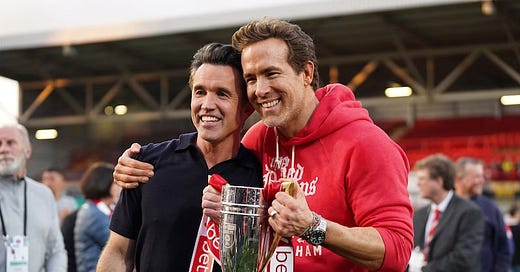Wrexham’s $475M Play: How a Hollywood-Sized Bet Created Football’s Wildest Return
A $2.5M non-league gamble has become a global case study in fandom, storytelling, and the business of belief.
The Hollywood script nobody saw coming has now hit its biggest twist yet: Wrexham AFC, once a non-league footnote, is seeking investors at a $475 million valuation. That’s not a typo. From $2.5 million to $475 million in just four years. A 19,000% rise. The kind of jump that makes venture capitalists salivate and seasoned sports execs question everything they thought they knew about club valuation.
When Ryan Reynolds and Rob McElhenney bought Wrexham in 2021, plenty assumed it was a publicity stunt. A sentimental project with a documentary angle. But that underestimation is exactly what allowed them to build the most compelling grassroots-to-global rebrand football has seen in decades.
Now, firmly into the Championship for the 2025–26 season and a fresh capital raise on the table, Wrexham isn’t just playing catch-up with the traditional elite; it’s actively redefining how value is created in football.
To put it in context: Sheffield United, also in the Championship, sold in December for £111 million. ($135 M). Everton, in the Premier League, recently changed hands in a deal estimated at £400 million ($500 M). Wrexham’s $475 million valuation sits closer to the top flight than to its peers. It doesn’t make sense on paper until you stop looking at it like a football club and start seeing it for what it really is: a global entertainment asset with football as the hook.
What Reynolds and McElhenney bought wasn’t just a club. It was a blank slate. A team with history, yes, but more importantly, a community desperate for hope and a story waiting to be told. The “Welcome to Wrexham” series wasn’t content marketing. It was cultural immersion. It turned the club into a narrative engine, where promotion battles and stadium rebuilds became binge-worthy television. That story didn’t just bring in fans. It brought in believers. And believers spend money.
Wrexham’s revenue reportedly hit £26.7 million ($35.6 M) for the fiscal year ending June 2024, a 155% increase on the year before. That kind of growth at this level is unheard of. It reflects something more potent than ticket sales: merch drops, global sponsorships, content licensing, and digital scale. The value isn’t in matchday, it’s in meaning. The club has cracked something others haven’t: emotional equity that converts directly into commercial value.
Follow me for more football, life, and other sports updates: Instagram
But even fairy tales need funding. As the club moves into the Championship, the financial reality gets sharper. Average player salaries triple. Operating costs balloon. Infrastructure upgrades like the planned expansion of the stadium don’t come cheap. That’s why a capital raise now makes sense. Not because the project is faltering, but because it’s maturing. The new money would fund that growth.
Still, the valuation figure raises eyebrows. The club sold 15% to the Allyn family in October 2024 at a reported £101 million ($136 M) valuation. Now, just eight months later, that number has more than tripled. Some will say it’s opportunism. Others will call it delusion. But to dismiss it entirely is to miss the point. In today’s sports economy, brand resonance often trumps league placement. Wrexham might not be in the Premier League, but it already lives in the minds of fans and media like it is.
The Dallas Cowboys of the NFL are a prime example; they haven’t reached a Super Bowl since 1996, yet they’re in a league of their own as the most valuable sports brand in the world, valued at $11 billion, or they were on their own until yesterday’s announcement of the Los Angeles Lakers sale going ahead for $10 billion. For context, Real Madrid is valued at $6.6 billion.
It’s not without risk. If the team stalls in the Championship, or worse, drops back down, the fragility of narrative-based valuation will be exposed. And as other clubs try to replicate the “Wrexham model,” saturation is inevitable. Not every underdog story scales. Not every celebrity owner understands what they’re stewarding.
But here’s the thing: Wrexham didn’t just get lucky. It was intentional. The owners embedded themselves in the town. The show was made with care, not exploitation. Commercial deals weren’t just about logos, but about aligning with the mythology being built. That’s why this valuation, absurd as it may seem, is being taken seriously by the market. It’s not just hype. It’s strategy.
Football’s traditionalists may scoff. But Wrexham is operating in a different arena now. It sits at the collision of culture, media, and sport, where attention is the currency, and authenticity is the differentiator. Welcome to 2025.
That’s why it’s worth watching whether the club finds an investor at that $475 million figure. Not just to validate the valuation, but to signal a new era in how football clubs are funded, scaled, and perceived.
The old rules said your value was dictated by your league, your trophy cabinet, your gate receipts. Wrexham tore those rules up. They sold a story. And that story, it turns out, is worth almost half a billion dollars.
Thanks for reading, David Skilling.
If you hit the like button, you’ll be doing me a huge favour, and if your business needs sports writing, wants to discuss advertising, or you have PR stories to pitch, feel free to get in contact.
If you know someone who will enjoy this article, please share it with them.




